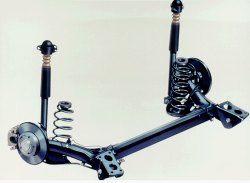A velomobile is something to have. But it is manufactured in limited numbers and expensive (I will name some makes:
velomobiel.nl,
leitra.dk,
go-one,
leiba.de,
aerorider.com,
sunrider-cycles.com,
alligt.nl,
dutchbikes.nl). Building it yourself is a good alternative and very much fun. This blog is dedicated to the development of a do it yourself velomobile.
 |
| The Alleweder Velomobile (photo Flevobike) |
I was involved in the development of the do it yourself Alleweder velomobile at the
Flevobike company in 1992. It was my job to improve and adapt the design of Bart Verhees.
Bart Verhees is a very practical engineer and an experienced airplane designer. His Alleweder velomobile is build like an airplane: riveted aluminum sheet. At that time I saw the beautiful shapes that are possible using bent sheet only. And this idea never left me.
 |
| The electric machine |
Together with designer Ronald Meijs we developed an electric car. It was made of an aluminum-polypropylene sandwich sheet (0.2-2-0.2 mm). This was a new material of Hoogovens named Hylite. It was aimed at the automotive industry.
 |
| Me and my first plywood car on a trip to Boulonge sur Mer |
But my true love is human power and a year later I travelled to France in my first plywood velomobile. It was a 'head in' design and on that trip a learned that the fun of cycling is to feel the air flow along your head. But the concept of a velomobile of airplane plywood was proven. I made a new head out design which was build by
Paddy Milford. It is has been hanging in my garage for 10 years now but recently
Sjaak Bloemberg is working to get it on the road.
 |
| The De Havilland Mosquito: a plywood construction build in 1940-1950, (© FlightGlobal) |
Wood is a very interesting material for velomobiles because of its low density. In the construction of the velomobile body the sheet stiffness is more important than its strength. The stiffness of the sheet is very much determined by its thickness. On stiffness relative to mass only sandwiches of alternative materials like carbon-aramid-epoxy with foam can compete with birch plywood. But building sandwiches is laborious and expensive and it is only recently that velomobile manufacturers offer bodies with sandwich sheet. For your information I will list some densities (kg/dm^3): birch plywood 0.7, aluminum 2.7, glass fiber 2.55, carbon fiber 1.75-1.95, polyester 1-1.45, epoxy 1.1-1.3. Look at the site of
Jan Hermhart for an example of plywood in aeroplanes.
My aluminum Alleweder was over 30 kg, my first plywood velomobile 27 and the second will be around 23 kg ! As soon as the second prototype has travelled its first 100 km I will get back to you. Let me know if you would like to be involved !
P.S. I'm not the only one:
mosquito-velomobiles ,
gigomobile ,
Friend Wood,
coronn











